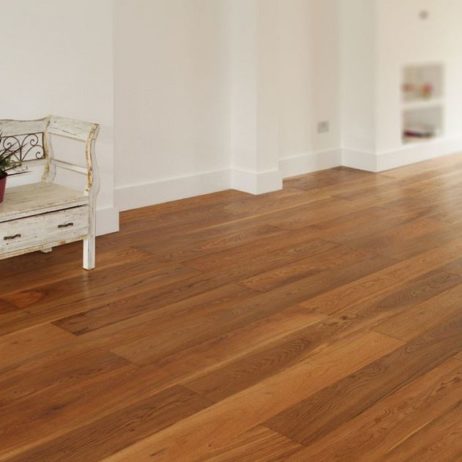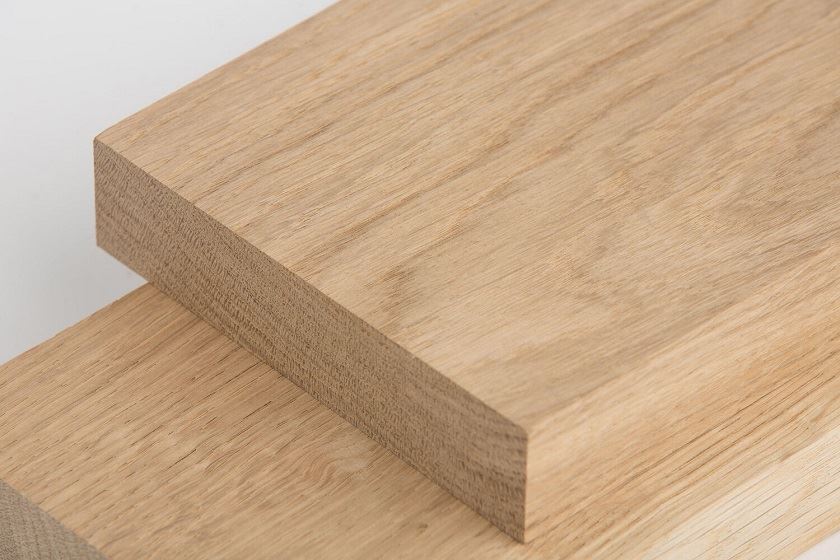
European oak flooring is one of the most popular flooring materials in Europe, the United States, and Australia. Because it is easy to find and abundant and available to everyone, it is very durable and easy to work with.
With American oak, there are two main types, white oak and red oak, and both have their own fans. Both are very durable and beautiful and easy to work with, which means that the oil content in them will not interfere with the finishing process, and different methods can be used to finish American oak flooring. For example, polyurethane or oily methods are well compatible with it.
White oak hardwood has a slightly denser texture than red oak. Thus, the janka rating for white oak is 1360 and the for red oak it’s 1290.
White oak and red oak have different colors and grains. White oak has a firmer grain pattern and is slightly darker than red oak. Although white oak can have shades of pink, it is mostly brown / gray. The graining of red oak are slightly more pronounced, open and linear than white oak. Red oak has brown colors, but its most noticeable color range is pink / red.
Now that we have a brief overview of American oak floors. It’s time to take a look at another type of oak that has become very popular lately. Namely, European oak.

European oak is a very beautiful hardwood that originated in several European countries – this type of oak is most commonly used in countries such as France, England, and Germany. European oak is also known by other names such as French oak or English oak.
European oak has a Janka 1360 rating, which is the same as American white oak.
Aside from the geographical difference and origin, which in themselves cause changes in the oak’s appearance, European oaks are distinguished from American oaks by other secondary characteristics, such as spectrum color and different grain size. European oaks have a softer and gentler grain than American oaks. American oaks often tend to have a very pronounced grain.
American red oak has a pinkish tint with some brown tones in it. While the main color spectrum of American oak is white, it is usually gray or slightly pinkish brown. European oaks, on the other hand, are darker in color and have a warm brown tone.
European oaks are best known for their width and thickness. Because of the nature
and the conditions under which the European oak grows, the sapwood of the European oak is wider and thicker than its heartwood compared to the American oak.
The sapwood is usually more distinct than the heartwood and has fewer differences. And the heartwood of the tree is the area of the tree where there are knots of the wood that are worm-eaten and darker in color.
Because the sapwood is thicker in European oak, the pieces of wood obtained from it are also simpler and wider.
The method of grinding hardwood is also completely different from the American oak mill method. In fact, many American mills have taken an interest in the European oak milling method and have switched to milling hardwood the same way.
European Oak is Live Sawn. Live saw is when the tree is sawed from right to back. The beauty of a live saw is that all the different cuts of the hardwood are included in this particular type of cut. This gives the floor a beautiful look with the natural grain visible throughout the wood. This floor cut makes the hardwood floor very stable.
American oak is typically cut using three main sawing methods: plain, split, or quartered.
European oak is finished with oils that are absorbed by the wood itself, and should not be confused with the oil-based polyurethane process. Technically, an oil-based or water-based polyurethane is a URETHANE finish.
The oil used to finish European oak flooring penetrates deep into the wood and seals it by closing the pores and porosity of the hardwood. The wood is usually sealed immediately after contact with the oil and quickly.
An oil sealer has a more natural look than an oil or water-based polyurethane sealer. An oily coating penetrates the wood instead of sitting on the hardwood surface. The grain of the wood is noticeable and you can walk on and use the hardwood. Rubbing a polyurethane with water or oil base, on the other hand, does not soak into the wood but acts as a protective sealant. If you use the floor with oily or water-based polyurethane, you’re actually walking on the sealant rather than the floor intself.
Water-based oil or polyurethane finishing, the most common in the United States, do not resemble polishing with wood oil. By using multiple coats, they protect the surface of the work and create a protective layer
Oil finishes are becoming more popular in the United States, and many manufacturers make great products for finishing their floors.
You can finish American oak flooring with oil. To do this, you will need to hire a qualified supplement. The method of use is different from using urethane base (whether oil or water).
As in any case, there are advantages and disadvantages in the choice between a urethane coating and oil.
Engineered wood flooring has advantages and benefits over solid wood, for example, it is less harmful to the environment and less expensive. In this article, we will go over the advantages and disadvantages of oak flooring and highlight important points to consider when buying. If you want to know what the importance of Engineered timber and Oak flooring is, and if you want to know the wide plank flooring that all architects and interior designers call, read on.
We talked about Engineered timber Pros and Engineered timber Cons before, you can take a look.
Pros
Cons
Engineered wood flooring has been around for about 20 years. In recent years, European oak engineered floorings have surged in popularity and is now the most desirable choice for wood flooring. Read on to find out why.
European oak, or French oak, is an extremely hard wood that grows slowly. Of course, this wood originated in Europe. It has been used for centuries to build ships, make barrels, and produce quality furniture. . . But most importantly, it has been used for flooring! The reason this European oak is so sought after is because of its key natural properties, which are listed below:
So why does everyone want a European oak? European oak has a unique grain pattern and variety compared to other hardwoods or American oak. This is mainly due to the slower growth cycle, which results in a firmer grain, and the way the wood is cut is not ineffective.
There are three different types of “cuts” for American oak: Plain sawn, Quarter sawn, and Rift. Depending on how the tree is cut, you will get one of these grain patterns.
In the case of the European oak, which is usually cut in France or Germany, this method is begun by cutting a “square” from the middle of the tree log, called the cant. The result of this method is a wider board, typically 170 mm to 250 mm wide.
The central part has a simple and with amazing plain sawn pattern, next to it there is a unique Rift and a quarter grain pattern, and all of this can be seen on one board. Having all three grain patterns in one piece of wood makes European oak timber very unique and popular.
Wondering why engineered wood flooring is superior to solid hardwood flooring? The reason is the way it is manufactured and produced. A piece of solid wood as lumber takes a long time to adapt to the environment and withstand temperature, humidity and environment. Therefore, thin solid wood panels are made to minimize the possibility of this happening.
Engineered wood panels are so called because they are made by gluing multiple layers of farmer’s plywood together in different directions to provide strength. A layer of pure European oak is then glued down as the top layer – this wear layer can typically be 2 mm to 5 mm thick, which will last for decades and can be used in the future. It is sanded or finished several times.
The thickness of the top layer of european oak wear is typically the same as what can be used in a traditional solid plank – so it does not harm the plank in terms of wear and longevity.
The basis of engineered construction of these floors is the key to their durability and strength, because of its strength and durability it no longer deforms like solid wood.
Therefore, it can be made into wider boards to which a layer of oak is glued to the top.
Wide and long boards of European oak are highly valued by architects and interior designers to give an impressive look to a large room.
Obviously, engineered timbers are more moisture resistant than solid wood boards, although wood floors should not be used in places where high humidity is expected.
Since engineered wood flooring is usually made of durable plywood, it is more environmentally friendly than solid wood flooring made of European oak.
The slow growth of European oak is essential to achieve this unique look and durability, and most of the wood needed for planks is sourced from forest regeneration forests.
The installation of engineered European oak planks is effortless. They adapt very quickly to the installation environment. In the “floating floor” installation method, they can be quickly installed on any floor that is smooth and healthy.
Take a look at floating floor installation Pros and Cons
Since they are already finished, you can use and walk on them after installation.
This is a very different scenario from traditional planks, which require longer tolerance, multiple sanding stages after installation, and multiple coats of varnish.
Design – Choose the color, finish and width of the planks to match the rest of your decor. Wide planks with a matte or semi-gloss finish are usually very popular. Engineered oak flooring comes in a variety of colors, from light lime to dark chocolate with a dark grain.
Real oak – make sure what you are buying is European oak. If the description only says oak or does not specify the species, it may be a hardwood sold as European oak timber.
Finish Type – With prefinished flooring, you save time and have fewer hassles. You can find scratch resistant surfaces in a variety of colors and finishes. Examine European Oak timbers for UV protection, as this is important in Australia where light and sun exposure from windows is high.
Panel size and thickness – If you are looking for high quality planks, it is better to use panels with a thickness of at least 14 mm, then you can feel the strength of the panels. Also, if the desired space is large, we recommend using longer boards.
Pay attention to the wear layer – Engineered European Oak planks must have a wear layer that can withstand at least two sandings and repolishing in the future. These floors can last for decades despite the wear and scratches that occur in the home. The thickness of the wear layer is only 2 mm for some cheaper floors, but 3 mm or more is recommended.